
|
Ukiyo-e Prints浮世絵版画 |
|
formerly Port Townsend, Washington now Kansas City, Missouri |
| UTAGAWA KUNIYOSHI |
| 歌川国芳 |
| 1797-1861 |
| Series: Dai-Nippon Rokujūyo-shu no Uchi |
| 大日本六十余州内 |
| "Sixty Odd Provinces of Great Japan - Dramatic Chapters" |
|
Subject:
Takagi Umanosuke in Bingo (備後国) Province |
| Date: 1843-5 |
| Censor: Watari (Watanabe Jiemon) |
| 渡 |
|
Publisher: Fujioka-ya Hikotarō |
|
藤岡屋彦太郎 |
|
Signature: Ichiyūsai Kuniyoshi ga |
|
(The inset is by Kuniyoshi's pupil Yoshisato) |
|
Size: 14 1/4" x 9 3/4" |
|
Condition: Trimmed at the top and somewhat at the bottom, slight soiling, worm track below text on upper right, thin backing, good color |
|
There are other copies of this print at the MFA in Boston
and
|
|
SOLD! THANKS R! |
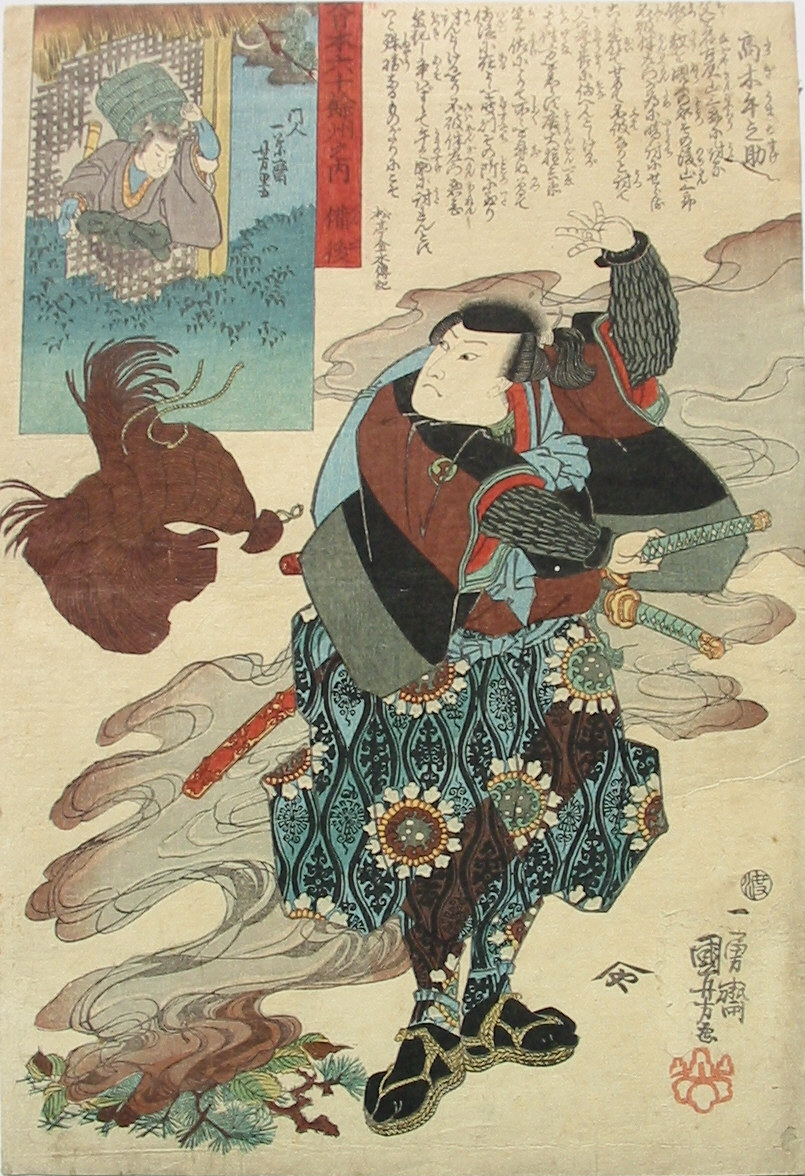 |
|
WHERE WAS BINGO PROVINCE?
備後国
It was located in what is now the eastern part of Hiroshima prefecture east of Hiroshima city. The Bingo Channel forms part of the Inland Sea at the mouth of the Nuta River at the town of Mihara. |
|
|
|
|
|
One of my pet peeves has always been and still remains references to place names when there is no map displayed. I realize that the map above is rather crude, but hopefully it will give you an idea of the location mentioned in this print. |
|
Oh so sweetly subtle! |
|||
|
|
|||
|
Today is February 17, 2004 and I just noticed something(s) new about this print. Of course, you will say, "But he should have seen that sooner!", but that is not always the case.
I have found that over the years when I would revisit favorite and not so favorite paintings in museums I would often see something new in them that I had not noticed in the previous 1,000 visits. Rather than being startled I am always delighted.
The other night I invited a young couple over for dinner. Afterwards we looked at Japanese prints. Because of the logistics, them on the couch and me in a chair opposite, I found myself looking at these art works upside down. This is not a normal view for me, but it did remind me of the practice of so many famous European artists who would look at their drawings or paintings in progress reflected in a mirror. This would always give them a new perspective. and so it was true with my upside down view: lots of new details emerged which I had never noticed before.
Early this afternoon I was looking more closely at the print on this page and noticed the placement of mica in areas glittering in the light as I turned the sheet somewhat sideways. Then, even more remarkably, I noticed the subtly printed areas of the main figure's costume which displayed the armor or tortoiseshell motif. Those areas had always looked like they were printed with solid browns and Blacks, but they were not. Even though I am not the best photographer I have tried to capture the delicate differences in shade and tone by taking shots of the print at a very sharp angle. I have also included an image from another print taken in the same way, but which I have not put on-line yet. I hope that these can be seen clearly enough --- clearly enough for you to go revisit some of the prints already in your collection. |
|||
|
|
|||
|
The reddish brown and black areas within the yellow outlines appear to be printed flatly at first glance, but look at the detail taken below seen from a different angle and in different lighting. I hope you can see it. |
|||
|
|
|
|
|
|
|
|||
|
Below are two similar examples which from a print taken straight on and at an angle. |
|||
|
|
|||
|
|
|
||
|
|
|||
|
|
|
||
|
Above is an example from a print by Hokushū. |
|||
|
|
|||
|
We know. We know...sigh! The information I have provided above is nothing new to anyone truly familiar with Japanese prints. However, this has to be new to someone out there. |
|||
|
|
|||
|
For comments on and further examples of the armor or tortoiseshell motif click on the detail below. |
|||
|
TATEWAKU 立涌 AN ANCIENT MOTIF |
|
Detail above from a print by Kuniyoshi. |
|
If you were to look at one thousand, two thousand, ten thousand, even fifty thousand Japanese prints after a while you would begin to notice the repetition of certain patterns --- that is, of course, if you have a half way decent memory. One of those patterns is the double wavy lined one which narrows then bulges and then narrows again over and over. Often in each of the bulging fields there are other repetitive motifs. |
|
Detail above from a Koryusai print. |
|
The tatewaku motif may have its origins in a Chinese patterns. |
|
Detail above from a Hiroshige print. |
|
There are a number of subgenre of tatewaku. When the bulge is filled with clouds it is referred to as a 'cloud' tatewaku. Chrysanthemum filled are known as 'chrysanthemum' tatewaku. The same with wisteria, bamboo, pine needles, |
|
Detail above from an Eizan print. |
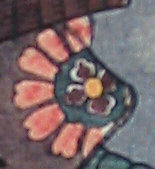 |
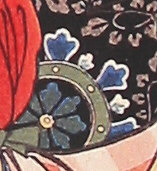 |
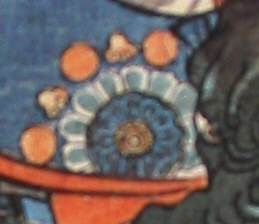 |
||
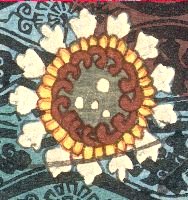 |
||||
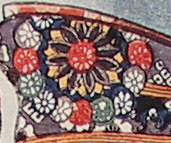 |
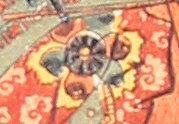 |
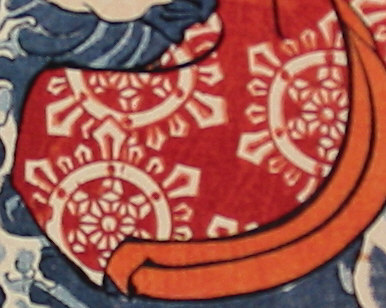 |
 |
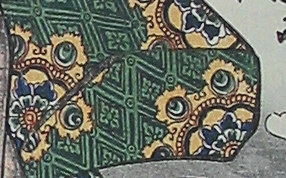 |
|
One of the fascinating things about presenting my inventory of prints to you on the Internet is that I begin to look much more closely at some of the design elements which in isolation could be so easily passed over as merely decorative. However, as you can see from all of the other Kuniyoshi fabric details here this artist had a particular affinity for what I can only describe as wheel-like florets. These often have the flavor of the tantric wheel, i.e., the Buddhist wheel of the law, but without the spiritual connotation.
Each of us has our own unique way of speaking. No matter how large our vocabulary we always fall into the same patterns. This has enabled scholars to determine which elements of great works like the Bible or Homer are apocryphal. The habit of repetition is true too of artists and has been used by experts to detect which works are real, which are by students and followers and which are out and out fakes. Those of you who are familiar with the Rembrandt Research project know exactly what I am talking about. |
||||
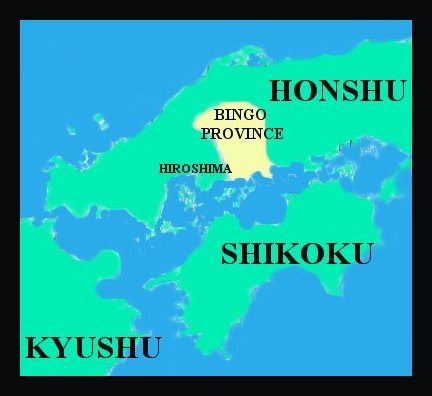

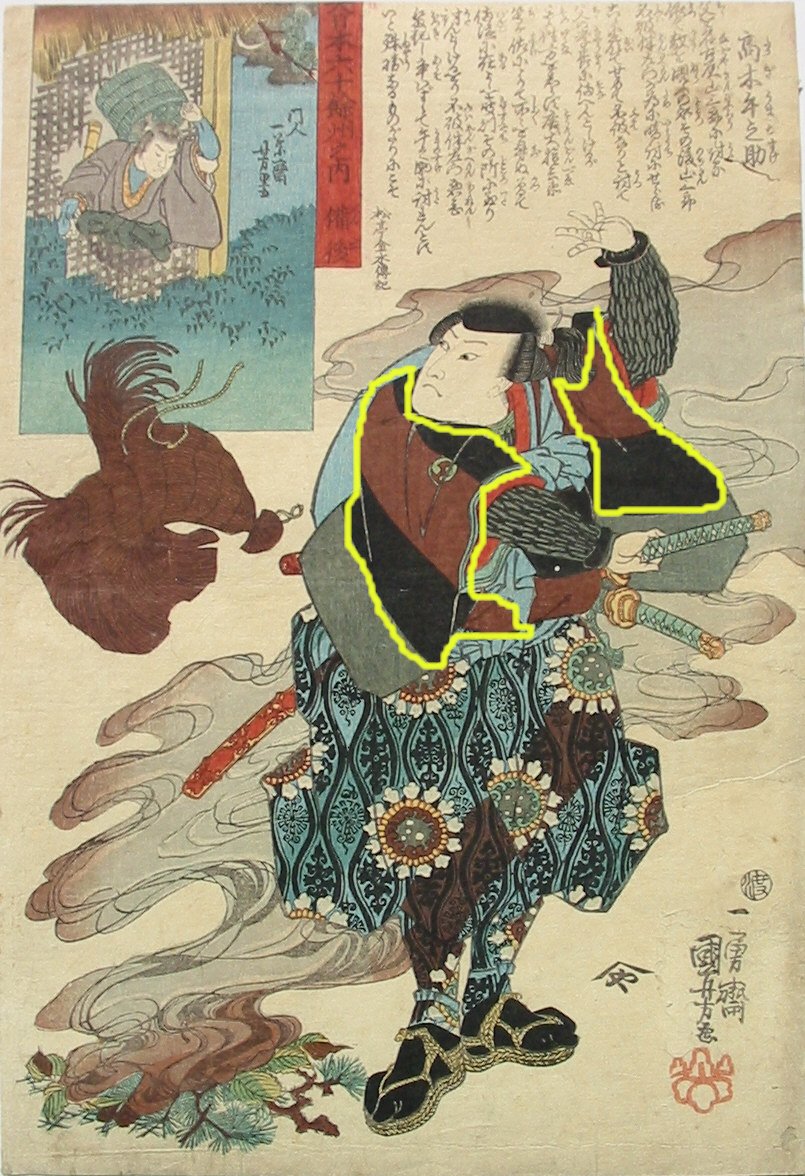



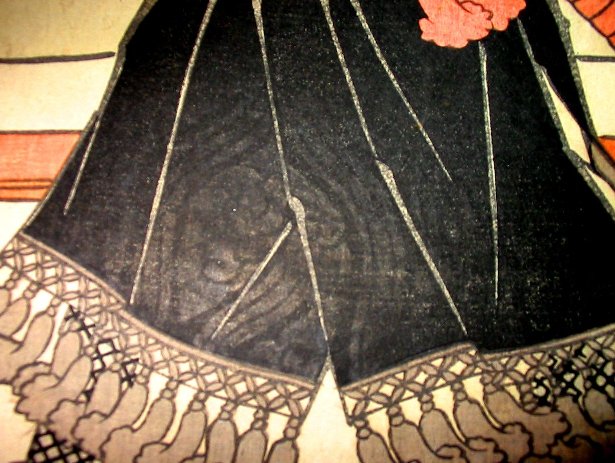
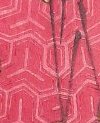
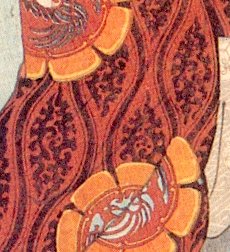

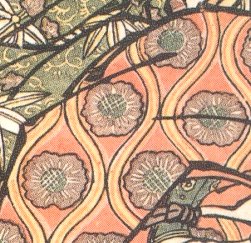
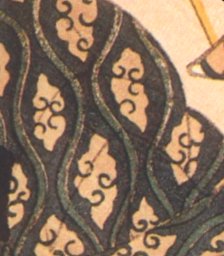
 HOME
HOME